This step by step diy project is about 10×24 field shed plans. I have designed this large run in shed, so you can store lots of items. This shed is ideal for stacking hay or other agricultural equipment items. However, I recommend you to take a look over the rest of my woodworking plans, if you want to get more building inspiration.
When buying the lumber, you should select the planks with great care, making sure they are straight and without any visible flaws (cracks, knots, twists, decay). Investing in cedar or other weather resistant lumber is a good idea, as it will pay off on the long run. Use a spirit level to plumb and align the components, before inserting the galvanized screws, otherwise the project won’t have a symmetrical look. See all my Premium Plans HERE.
Projects made from these plans
10×24 Field Shed Plans
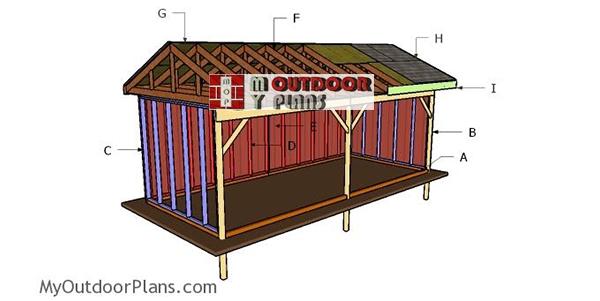
Building-a-10×24-field-shed
Cut & Shopping Lists
- A – 2 pieces of 4×4 lumber – 138 3/4″ long, 2 pieces – 144″ long, 2 pieces – 116 1/2″ long SKIDS
- B – 3 pieces of 4×4 lumber – 132″ long, 2 pieces of 2×12 lumber – 144″ long, 4 pieces of 2×4 lumber – 36″ long POSTS
- C – 2 pieces of 2×4 lumber – 116 1/2″ long, 1 piece – 113″ long, 7 pieces – 91 1/2″ long 2xSIDE WALL
- D – 1 piece of 2×4 lumber – 144″ long, 2 pieces – 140 1/2″ long, 7 pieces – 91 1/2″ long 2xBACK WALL
- E – 10 pieces of T1-11 siding – 48″x96″ long, 2 pieces – 24″x96″ long SIDING
- 7 pieces of 4×4 lumber – 12′
- 2 pieces of 4×4 lumber – 10′
- 3 pieces of 2×4 lumber – 16′
- 6 pieces of 2×4 lumber – 10′
- 6 pieces of 2×4 lumber – 12′
- 30 pieces of 2×4 lumber – 8′
- 2 piece of 2×12 lumber – 12′
- 11 pieces of T1-11 siding – 4’x8′
- 6d nails, 2 1/2″ screws, 3 1/2″ screws
- wood filler , wood glue, stain/paint
- shed anchors
Tools
![]() Hammer, Tape measure, Framing square, Level
Hammer, Tape measure, Framing square, Level
![]() Miter saw, Drill machinery, Screwdriver, Sander
Miter saw, Drill machinery, Screwdriver, Sander
Time
Related
- PART 1: 10×24 Field Shed Plans
- PART 2: 10×24 Field Shed Roof Plans
How to build a 10×24 field shed
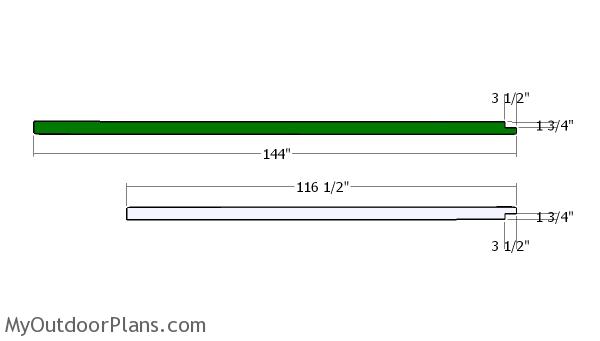
Skids
The first step of the project is to build the skids for the field shed. As you can easily see in the diagram, you need to make cuts at both ends of the beams. Use a saw to make 1 3/4″ deep cuts at both ends and then remove the excess with a chisel. Smooth the surface with sandpaper.
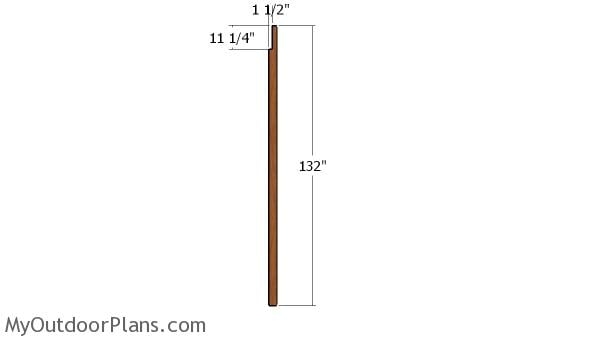
Building the posts
Use 4×4 lumber for the front posts. As you can see in the diagram, use a circular saw and a chisel to make a recess to the top of the posts. Use sandpaper to clean the recess.
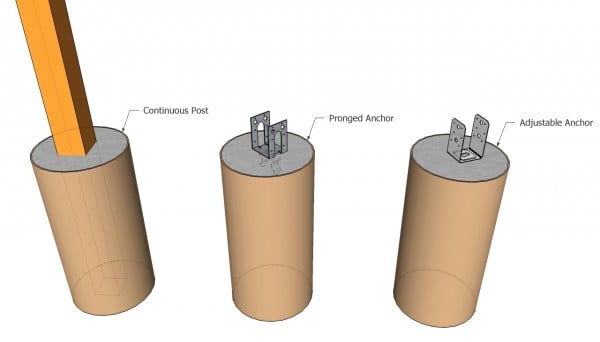
Anchoring the posts of the anchor
Dig the holes 3′ deep (or under the front line) and about 12-13″ in diameter. Compact a layer of gravel to the bottom of the holes and then fit the tube forms. Fit the posts, align them and plumb them with a spirit level. Fill the forms with concrete, while the posts are locked into place with temporarily braces. If you use anchors, you need to align and set them into concrete. Fit the posts after the concrete dries, using lag screw.
Smart tip: Read the local building codes, so you dig the holes at the appropriate depth.
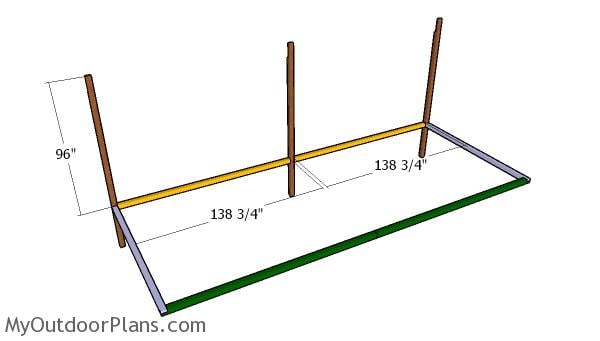
Assembling the skids
Remove the vegetation layer and make sure you comply with the local building codes. Fit the skids on the location. Make sure the corners are square and then measure the diagonals. Drill pilot holes and insert 3 1/2″ screws to lock the skids together tightly. Alternatively, you can even anchor the skids to the ground, if you live in an area prone to strong winds. Secure the skids to the vertical posts with screws.

side-wall-frame—10×24-run-in-shed
Use 2×4 lumber for the side wall frames. Cut the components at the right dimensions and then lock them together with 3 1/2″ screws. Drill pilot holes before inserting the screws, to prevent the wood from splitting. Place the studs every 24″ on center and make sure the corners are square.
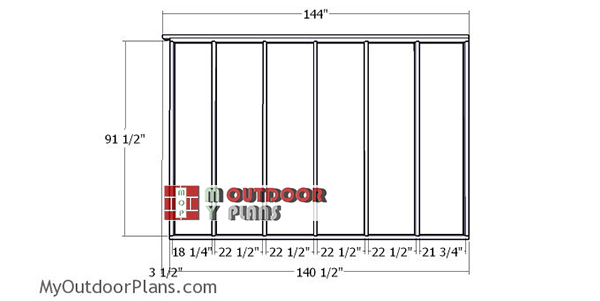
Back-wall-frame
Build the back wall of the shed from 2×4 lumber. Use two sections for the back wall. Drill pilot holes through the plates and insert 3 1/2″ screws into the studs. Align the edges and make sure the corners are square. Alternatively, you could use framing nails and a framing gun.
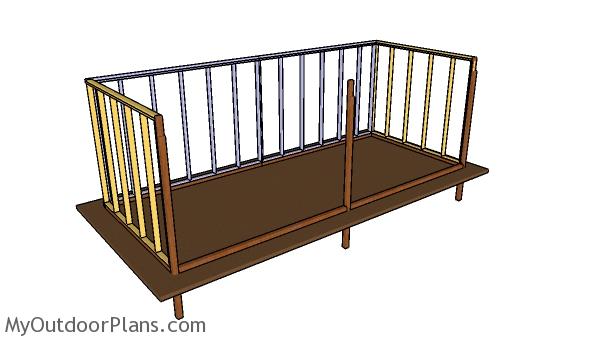
Assembling the shed frame
Fit the wall frames to the floor of the shed. Align the edges with attention and plumb the walls with a spirit level. Drill pilot holes through the bottom plates and insert 3 1/2″ screws into the floor. Lock the adjacent walls together tightly using 3 1/2″ screws.
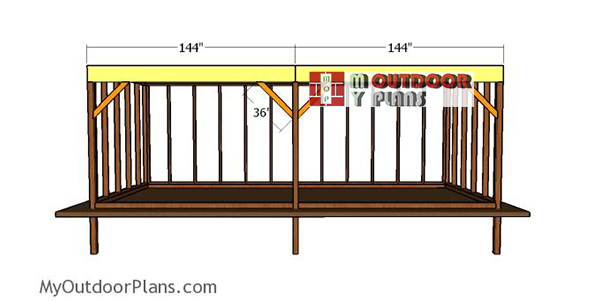
Fitting-the-top-support
Fit the 2×4 supports to the front of the shed. Drill pilot holes and insert 3 1/2″ screws. Fit the 2×12 beams to the top of the supports, as shown in the diagram.

Back wall siding sheets
Fit the siding to the back wall of the shed. Align the edges flush and leave no gaps between the sheets. Insert 6d nails, every 8″ along the framing.
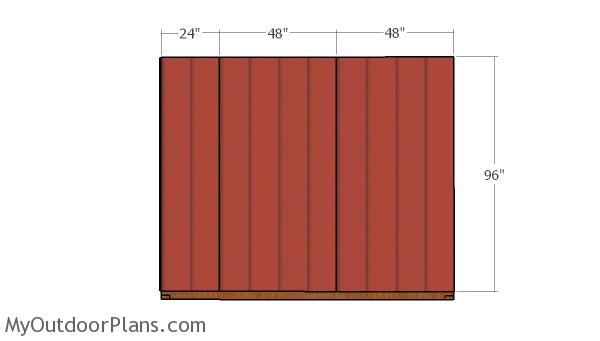
Side wall siding panels
Attach the T1-11 siding sheets to the sides of the run in shed, as well. Use the same techniques described above to get a professional result.
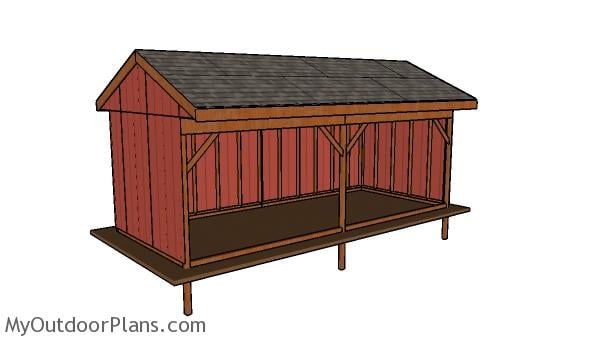
10×24 Field Shed Plans
Take a look over PART 2 of the project, so you learn how to build the roof.
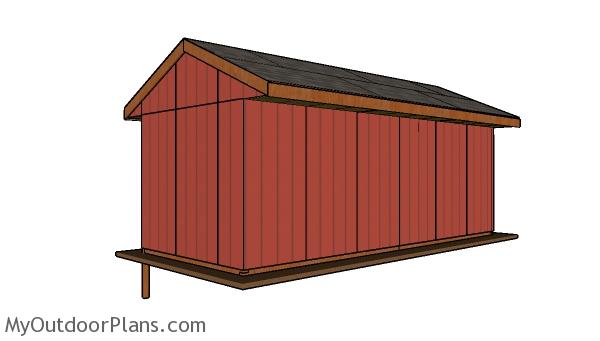
10×24 Field Shed Plans – back view
I have lots of other shed projects on the site so I recommend you to browse through all alternatives before starting the building project. See all my shed projects HERE.
This woodworking project was about 10×24 field shed plans free. If you want to see more outdoor plans, check out the rest of our step by step projects and follow the instructions to obtain a professional result.

